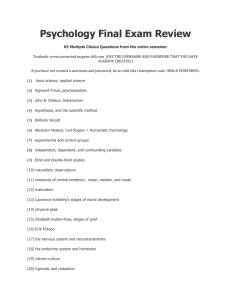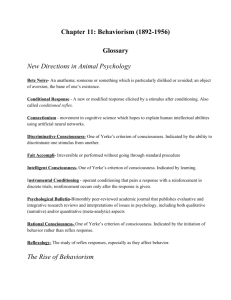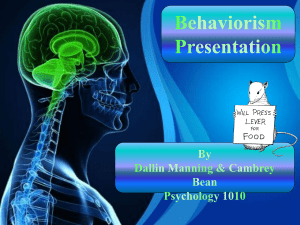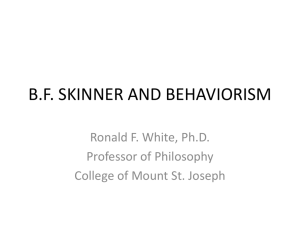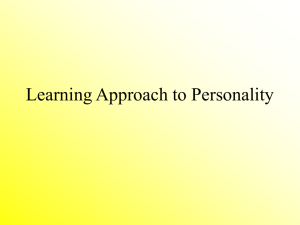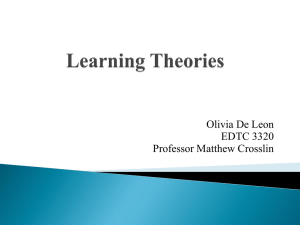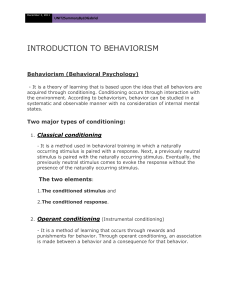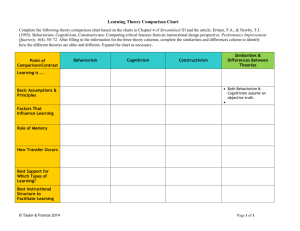File
advertisement
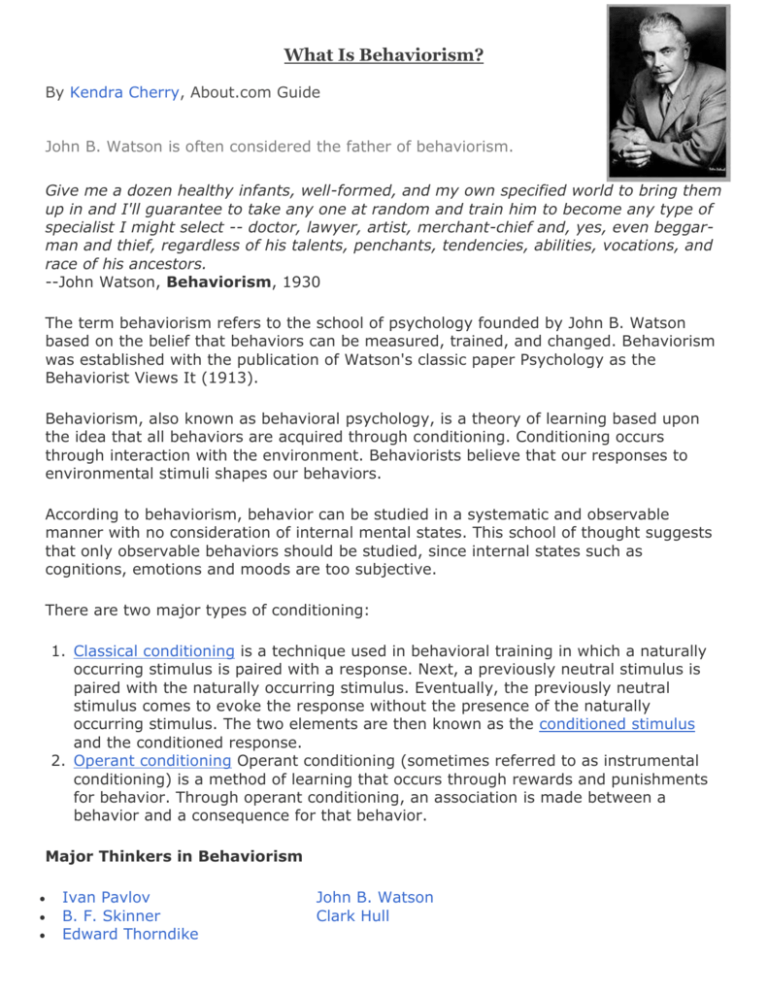
What Is Behaviorism? By Kendra Cherry, About.com Guide John B. Watson is often considered the father of behaviorism. Give me a dozen healthy infants, well-formed, and my own specified world to bring them up in and I'll guarantee to take any one at random and train him to become any type of specialist I might select -- doctor, lawyer, artist, merchant-chief and, yes, even beggarman and thief, regardless of his talents, penchants, tendencies, abilities, vocations, and race of his ancestors. --John Watson, Behaviorism, 1930 The term behaviorism refers to the school of psychology founded by John B. Watson based on the belief that behaviors can be measured, trained, and changed. Behaviorism was established with the publication of Watson's classic paper Psychology as the Behaviorist Views It (1913). Behaviorism, also known as behavioral psychology, is a theory of learning based upon the idea that all behaviors are acquired through conditioning. Conditioning occurs through interaction with the environment. Behaviorists believe that our responses to environmental stimuli shapes our behaviors. According to behaviorism, behavior can be studied in a systematic and observable manner with no consideration of internal mental states. This school of thought suggests that only observable behaviors should be studied, since internal states such as cognitions, emotions and moods are too subjective. There are two major types of conditioning: 1. Classical conditioning is a technique used in behavioral training in which a naturally occurring stimulus is paired with a response. Next, a previously neutral stimulus is paired with the naturally occurring stimulus. Eventually, the previously neutral stimulus comes to evoke the response without the presence of the naturally occurring stimulus. The two elements are then known as the conditioned stimulus and the conditioned response. 2. Operant conditioning Operant conditioning (sometimes referred to as instrumental conditioning) is a method of learning that occurs through rewards and punishments for behavior. Through operant conditioning, an association is made between a behavior and a consequence for that behavior. Major Thinkers in Behaviorism Ivan Pavlov B. F. Skinner Edward Thorndike John B. Watson Clark Hull Important Events in Behaviorism 1863 - Ivan Sechenov's Reflexes of the Brain was published. Sechenov introduced the concept of inhibitory responses in the central nervous system. 1900 - Ivan Pavlov began studying the salivary response and other reflexes. 1913 - John Watson's Psychology as a Behaviorist Views It was published. The article outlined the many of the main points of behaviorism. 1920 - Watson and assistant Rosalie Rayner conducted the famous "Little Albert" experiment. 1943 - Clark Hull's Principles of Behavior was published. 1948 - B.F. Skinner published Walden II in which he described a utopian society founded upon behaviorist principles. 1959 - Noam Chomsky published his criticism of Skinner's behaviorism, "Review of Verbal Behavior." 1971 - B.F. Skinner published his book Beyond Freedom and Dignity, in which he argued that free will is an illusion. Criticisms of Behaviorism Many critics argue that behaviorism is a one-dimensional approach to understanding human behavior and that behavioral theories do not account for free will and internal influences such as moods, thoughts and feelings. Behaviorism does not account for other types of learning, especially learning that occurs without the use of reinforcement and punishment. People and animals are able to adapt their behavior when new information is introduced, even if a previous behavior pattern has been established through reinforcement. Strengths of Behaviorism Behaviorism is based upon observable behaviors, so it is easier to quantify and collect data and information when conducting research. Effective therapeutic techniques such as intensive behavioral intervention, behavior analysis, token economies and discrete trial training are all rooted in behaviorism. These approaches are often very useful in changing maladaptive or harmful behaviors in both children and adults. Final Thoughts While behaviorism is not as dominant today as it was during the middle of the 20thcentury, it still remains an influential force in psychology. Outside of psychology, animal trainers, parents, teachers and many others make use of basic behavioral principles to help teach new behaviors and discourage unwanted ones. Article Questions 1. Read the quote at the beginning of the article. What do you think John Watson is trying to say about society and how we become the people we are today? Do you think the following quote is accurate? Give examples to support your opinion. 2. What do behavioral psychologists believe? What is the main premise behind their theory? 3. Define classical and operant conditioning. Can you think of examples where you have trained/behaved based on either? (think fears, commercials-appetites, rewards/punishments, learning skills in steps, the ringing bell at this school) 4. Can you train your behavior? Can you change what you are used to doing on regular basis? Ie why do we always sit in the same seats we sit-we are creatures of habit! Can you quit smoking, begin exercising, start studying more…How much behavior can we/should we change?? 5. What are the criticisms of behaviorist theories? 6. Why do we study behaviorism? What are the practical applications? Where is it used?
